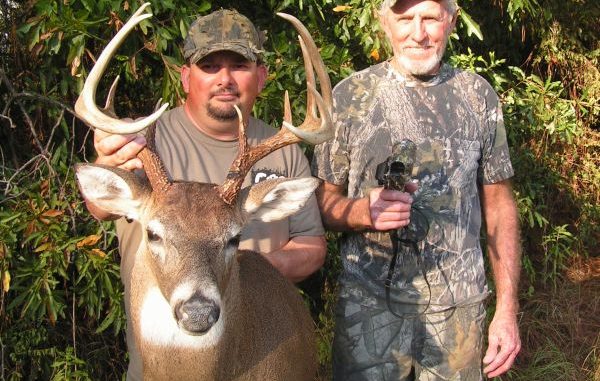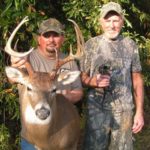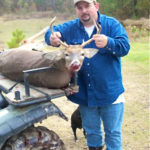
If you’re looking for a new hunting lease, it’s probably wise to search around Union Parish because it’s the indisputable deer-hunting champion.
They come from around Oakland, Litroe, Lillie, Linville, Pisgah, Spearsville and Mount Union. And Crossroads, Marion, Iron Bridge, Rocky Branch, Dean, Point, Walnut Hill and Truxno.
These small communities are dots so small they barely show on the map. Most don’t even have stoplights. Some don’t even have stop signs.
But what they do have is some of the best deer hunting in Louisiana.
Deer come from these dots on the map. Lots of them.
How popular is deer hunting in Union Parish? Name the only parish in the state for which deer have their own Facebook page.
Yes: It’s Union.
Its 905 square miles of rolling rural woodlands make it the state’s 11th largest parish by size. When you look at Union Parish from a Google Earth view, you see green. Lots of it.
And that’s one reason it once again produced the most deer in Louisiana during the 2014-15 season.
According to the state’s annual deer report, hunters took 3,016 deer last season. That’s the seventh year in a row Union has been at the top.
Deer hunting is to these towns and communities what LSU football is to Baton Rouge. People here love it. People from other places come to see. Some weekends and holidays during deer season, it seems like the Northeast Louisiana parish’s population of 22,340 doubles.
Deer habitat includes rolling hills, hardwood bottoms, pine plantations, swamps and river bottoms, cutovers — you name it, Union Parish has it.
Because so much of the parish is managed for timber, the edge ratio is high. The “edge” is where cutovers meet mature woods, thickets meet hardwood bottoms, and the bottoms meet river swamps. There’s something different everywhere you look.
And the deer thrive in that kind of habitat.
Just ask Kelly Patrick.
First, if you ask anybody here if Patrick is a good deer hunter, they’ll probably shake their head and say they never heard of him.
But ask them about “Dump” and they’ll say, “Yeah, he’s a good one.”
That’s another unique thing about deer hunters in Union: Use their real names and people have to scratch their head, but say a nickname and they’ll instantly know who you are talking about.
Kelly “Dump” Patrick is one of those. Born and raised in Union, he loves to hunt and doesn’t mind sharing his knowledge of the parish with others.
“There can’t be another place in the state better than here to live if you are a deer hunter,” Patrick said.
When he’s not on his day job in the oil fields, he’s in the woods, probably close to where he lives on a dead-end road that stops in the Ouachita River bottoms.
And he always starts his deer hunt looking for the right groceries.
“If I had to say one thing is more important for deer than any other, it would be acorns,” he said. “If you can find an acorn crop, you can find deer. Deer will walk right over a corn pile to get to the acorns.”
If you don’t have acorns where you hunt, you can likely find trails where the deer travel to those spots from their bedding grounds.
“Everybody feeds corn now, and that attracts a lot of deer,” Patrick said. “Deer feeders bring deer in at certain times and make it easier to kill them.
“But that doesn’t always work. There are so many people feeding now that many deer go nocturnal once the season starts. That’s especially true of the bucks — especially the big bucks. They get pretty wise.”
So what does that mean, in terms of upping your odds of success?
“Certainly, the right location is the key to success, and a lot of scouting and a little luck plays a part, too,” Patrick said. “It’s good to hunt the first weeks of the season, when there hasn’t been so much hunting already.
“But the best time is during the rut. When they go to chasing the does, they’ll slip up and get in places where hunters can get them.”
According to Patrick, the peak of the rut in Union Parish usually begins around Thanksgiving and goes at least a couple of weeks into December. It varies some according to the weather, but not much.
But this accomplished hunter said the active rut isn’t the only opportunity to kill a good buck.
“One other good time to get a good buck is right after the rut,” he explained. “They will be tired and off their guard a bit, and they will be hungry.
“They will come to food more than usual for the week or so after the rut is over.”
That’s usually toward the end of December and into early January.
Also, Patrick knows from experience that older bucks go places where there’s never been much hunting pressure. So he looks for those kinds of areas and uses two quite different approaches.
“I love to get high in the trees over food or the trails,” he said. “I have a couple of lock-on stands that are over 30 feet high.”
Patrick often hunts with a friend, Tommy Franklin, in the same tree. Frankln spends hours filming deer and Patrick’s hunts, as well as other hunting trips.
The second approach doesn’t include climbing trees.
“And then in some areas, I like to move around where I think the deer are, so I use ground blinds more than ever,” Patrick said. “You can get in a thicket without disturbing them so much.”
There’s a third approach that he doesn’t use often, but he laughingly gave up his secret.
“The biggest buck I ever killed, I killed him sitting on a 5-gallon bucket,” he said.
But no matter what tactic he chooses, Patrick takes pains to overcome his preys’ noses.
“A deer’s main defense is his ability to smell, so I am always careful to put fox urine scent or racoon urine scent on my boots when I walk in,” he said.
As a member of the Cedar Hill field staff, he recommended hunters give their scents a try. He also uses their can “bleat” call and grunt calls during the rut.
Patrick left us with one final tip that he can’t explain but swears is fact.
“I probably hunt the area around the edge of the river bottom more than anywhere else,” he said. “I don’t know what it is, but if it has been dry and it comes a big rain, the deer will move out of the bottoms and into the edge of the pine woods.
“Don’t ask me why; they just do. You can use that to find deer, too, when those conditions happen.”


